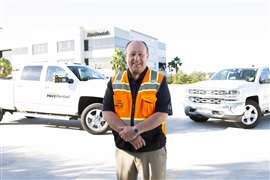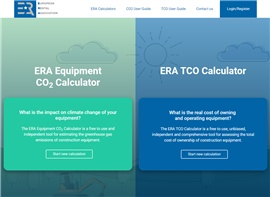Read this article in French German Italian Portuguese Spanish
Inside the mega-deal: Why Herc is banking on its H&E acquisition
04 June 2025
With this week’s completion of Herc’s US$5.3 billion acquisition of H&E Equipment Services, Murray Pollok considers the rationale behind the deal and provides Herc’s most recent views on market conditions.
 Photo: Herc Rentals
Photo: Herc Rentals
Earlier this week, Herc Rentals officially finalised its acquisition of H&E Equipment Services in a US$5.3 billion deal. The completion followed Herc’s decision at the start of the year to outbid United Rentals’ original US$4.8 billion offer for H&E.
Now, several months after Herc’s acquisition offer, it is worthwhile revisiting the reasons for the deal and what it will mean for the business.
What is the business logic of the acquisition?
The merger between Herc Rentals and H&E Equipment Services will create a company with a market share of around 6% in the USA, with pro forma revenues in 2024 of around US$5.2 billion. Herc’s 2024 revenues were $3.5 billion.
The deal will add Herc’s 453 locations to the 160 depots operated by H&E and create a fleet with an original equipment cost of around $10 billion. That compares to $21.4 billion for the United Rentals fleet.
In addition to the expanded footprint, Herc says the addition of H&E increases its density in key regions and expands its geographic diversification. For example, it says it will have a “leading presence” in 11 of the top 20 rental regions and improved urban density in seven of the top 10 rental market areas.
Herc says a key benefit will be revenue synergies through cross selling, marrying Herc’s broader specialty and general rental fleet breadth to H&E’s predominantly general rental customer base. This, said Herc, creates a large “white space” for growth.
Another key factor is that the larger fleet and expanded network will allow it to better serve the ‘mega projects’ sector, which both companies had previously highlighted as a big growth opportunity.
In this context, Herc said the specialty fleet adds premium returns that balance the price competitiveness of high-volume general rentals associated with such projects.
More widely, H&E represented a key opportunity for Herc to continue its growth trajectory. Had United Rentals succeeded in buying H&E, Herc would have been further distanced from United and Sunbelt Rentals, and would have had fewer avenues for transformative deals in the future.
Deal in the context of Herc’s growth record
Since 2020, Herc Rentals has more than doubled its rental revenues, rising from $1.54 billion in 2020 to $3.19 billion in 2024. Total revenue has increased from $1.78 billion to $3.57 billion, representing a compound annual growth rate of 19%.
Adjusted EBITDA nearly doubled as well, growing from $689 million in 2020 to $1.58 billion in 2024.
Alongside financial growth, the company has expanded its fleet from approximately 41,000 units to 64,000, while maintaining an average fleet age of about 47 months.
Over the last four years it has invested over $2 billion in more than 50 acquisitions, not including H&E. Herc said it had delivered a shareholder return of 544% since its spin-off from Hertz Corp in 2016.
The specialty synergy
Herc said it would leverage H&E’s footprint to significantly expand both its specialty and general rental businesses.
It has estimated annual revenue synergies - increased revenue opportunities as a result of the merger - of around $240 million within three years of the acquisition. It expects to realise 20% of revenue synergies within the first year, focused on general rental cross-selling, ramping up to 60% in the second year with specialty cross-selling, and the balance by the third year.
Herc’s specialty products include power generation, pumps, HVAC, floor care, trench shoring, and industrial tools, which generate higher profit margins compared to general rentals.
Herc’s specialty fleet is located at around 155 of its 453 locations, and H&E’s predominantly general rental customer base provides a strong opportunity to increase penetration and cross-sell specialty products.
Equally, said Herc, for general rentals, Herc’s product breadth — including ten times more category classes, electric and hybrid equipment options, and technology-enabled rental products — will enhance H&E’s offering.
H&E’s network will enable Herc to increase its share of spending across customer accounts, boosting fleet utilisation and revenue growth.
Current market conditions
 Larry Silber, Her president and CEO. Photo: Herc
Larry Silber, Her president and CEO. Photo: Herc
In April, Herc president and CEO, Larry Silber, said the company’s national account business continued to grow, supported by federal and private funding for major construction projects such as data centres, manufacturing facilities, and LNG projects.
It reported seeing no signs of cancellations or significant delays in 2025, with suggestions of ongoing momentum, particularly in microchip and pharmaceutical manufacturing sectors.
In contrast, local markets remain challenging. Herc said some segments, such as facility maintenance, municipal infrastructure, education and healthcare, continue to provide opportunities, but interest rate-sensitive projects are largely on hold.
Herc does not expect tariffs to significantly impact procurement costs in 2025 since most of its fleet is sourced domestically and pricing has been secured for the year.
Its outlook for 2025 is for revenue growth of between 4% and 6% (excluding the H&E deal), which represents a significant slowing down on recent years. Gross Capex will be between 10% and 30% lower than last year.
Preparing for the merger
On 29 May Herc expanded the size of its board of directors from seven to eight members. Under the terms of the merger, John M Engquist, who previously served on H&E’s board, has joined the Herc board, effective on 2 June.
Originally, both Engquist and H&E board member Suzanne Wood – a former CFO at Ashtead Group - were slated to serve on the board. However, Wood withdrew for personal reasons on 20 May. Herc said her decision was “not as the result of any disagreement between her and the company, its management, the board or any committee”.
As part of the wider preparation for the integration of the two companies, Herc has engaged Boston Consulting Group to support “cultural integration and change management”, to ensure that operational teams remain focused on serving customers during the transition.
The integration management office is led by one of Herc’s most senior field executives, said Herc, supported by a cross-functional team encompassing HR, IT and field operations.
Herc said it was committed to delivering on its integration targets and ongoing business commitments without disruption.
STAY CONNECTED



Receive the information you need when you need it through our world-leading magazines, newsletters and daily briefings.
CONNECT WITH THE TEAM









